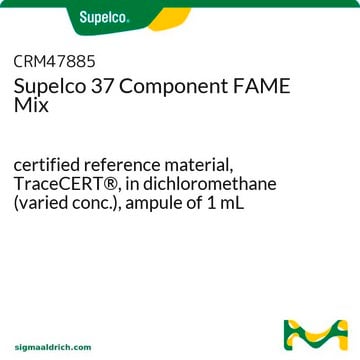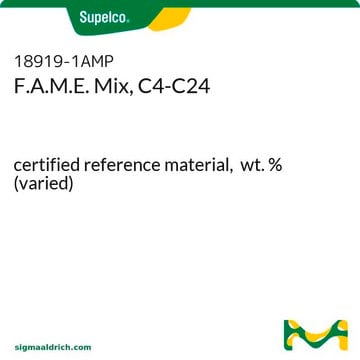Kluczowe dokumenty
89764
Undecanoic acid
analytical standard
Synonim(y):
Hendecanoic acid
Wybierz wielkość
1070,00 zł
Wybierz wielkość
About This Item
1070,00 zł
Polecane produkty
klasa czystości
analytical standard
Poziom jakości
Próba
≥99.0% (GC)
okres trwałości
limited shelf life, expiry date on the label
metody
HPLC: suitable
gas chromatography (GC): suitable
bp
228 °C/160 mmHg (lit.)
248-250 °C (lit.)
mp
28-31 °C (lit.)
Zastosowanie
cleaning products
cosmetics
flavors and fragrances
food and beverages
personal care
Format
neat
grupa funkcyjna
carboxylic acid
Warunki transportu
ambient
temp. przechowywania
room temp
ciąg SMILES
CCCCCCCCCCC(O)=O
InChI
1S/C11H22O2/c1-2-3-4-5-6-7-8-9-10-11(12)13/h2-10H2,1H3,(H,12,13)
Klucz InChI
ZDPHROOEEOARMN-UHFFFAOYSA-N
Szukasz podobnych produktów? Odwiedź Przewodnik dotyczący porównywania produktów
Powiązane kategorie
Opis ogólny
Zastosowanie
Kod klasy składowania
11 - Combustible Solids
Klasa zagrożenia wodnego (WGK)
WGK 1
Temperatura zapłonu (°F)
>233.6 °F
Temperatura zapłonu (°C)
> 112 °C
Środki ochrony indywidualnej
dust mask type N95 (US), Eyeshields, Gloves
Wybierz jedną z najnowszych wersji:
Masz już ten produkt?
Dokumenty związane z niedawno zakupionymi produktami zostały zamieszczone w Bibliotece dokumentów.
Klienci oglądali również te produkty
Active Filters
Nasz zespół naukowców ma doświadczenie we wszystkich obszarach badań, w tym w naukach przyrodniczych, materiałoznawstwie, syntezie chemicznej, chromatografii, analityce i wielu innych dziedzinach.
Skontaktuj się z zespołem ds. pomocy technicznej











